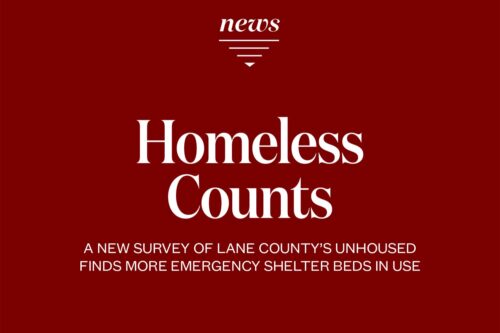
The number of unhoused people living in Eugene has remained stubbornly consistent over recent years, but new data show the changing ways the homeless here and across Lane County are spending their nights.
More unhoused people are finding temporary shelter than a year ago, Lane County officials say, thanks to their push for more low-barrier shelter beds.
Incoming Mayor Kaarin Knudson says, “Locally, we’ve made progress in some areas thanks to focused investments — fewer people are unsheltered compared to last year, for example.”
The new numbers come from the annual Homeless Point-in-Time Count, a one-night census to capture a snapshot of the unhoused in communities across the U.S.
Communities are required to carry out the count by the U.S. Department of Housing and Urban Development, which uses the data to help decide whether to allocate federal funds for housing and services to the unhoused. HUD also uses the data to make direct comparisons among cities.
HUD data have for years shown the Eugene/Springfield area with among the nation’s highest numbers of unhoused, given the overall population.
“It’s really meant to be a snapshot by which they gauge the overall trends,” says Jason Davis, the outreach information officer for Lane County Health and Human Services.
This year’s count took place on Jan. 31 and involved surveying homeless shelters while scores of volunteers interviewed unhoused people in alternative shelter programs like Rest Stops, microsites, and sanctioned vehicle camping.
The count identified 3,085 unhoused people, a 9 percent increase over last year. Nearly half of those people are chronically homeless.
County officials note one bright spot: The share of people who have some shelter at night is increasing, up 39 percent over last year.
County officials say nearly 300 more emergency shelter beds have been made available since last year through 10 different service agencies. They credit an emergency order issued by Gov. Tina Kotek in 2023 that awarded $18.5 million to Lane County to fund its homelessness reduction strategy.
For years, housing experts have seen the annual point-in-time count as necessary but flawed. The survey inevitably misses many unhoused people.
In 2021, Lane County launched an ongoing list of unhoused people. The county uses its Homeless Management Information System (HMIS) and Homeless By-Name List to collect data about unhoused individuals to better match people with housing and other services.
The HMIS estimates run higher than the annual point-in-time count because the numbers reflect information collected during an entire month, not a single night.
White Bird Clinic, which provides crisis, social, behavioral and health care services to people in need, participates in the PIT count by reporting its findings to Lane County through the HMIS system.
White Bird Clinic’s executive director, Jeremy Gates, says HMIS is the best tool Lane County has for understanding how to help its unhoused population.
If someone spent the night in a jail, hospital or temporary shelter due to harsh weather, the PIT survey question “Where did you stay last night?” could lead to inaccurate counts, Gates says.
But, “while not a perfect system, it does allow for a singular data gathering spot,” he says of the PIT count.
The Homeless By-Name List identified 4,295 unhoused people during January, about 1,200 more than the one-night survey identified. The HMIS count of unhoused people in May was 4,747.
Knudson says, “Any other challenge a person faces is better addressed when they have a stable place to be. Eugene and Lane County need more affordable, supportive, age-friendly, equitable housing solutions. As we build those long-term solutions, we need to bridge the gap with transitional shelter and support.” And that, she says, can be done through partnerships.